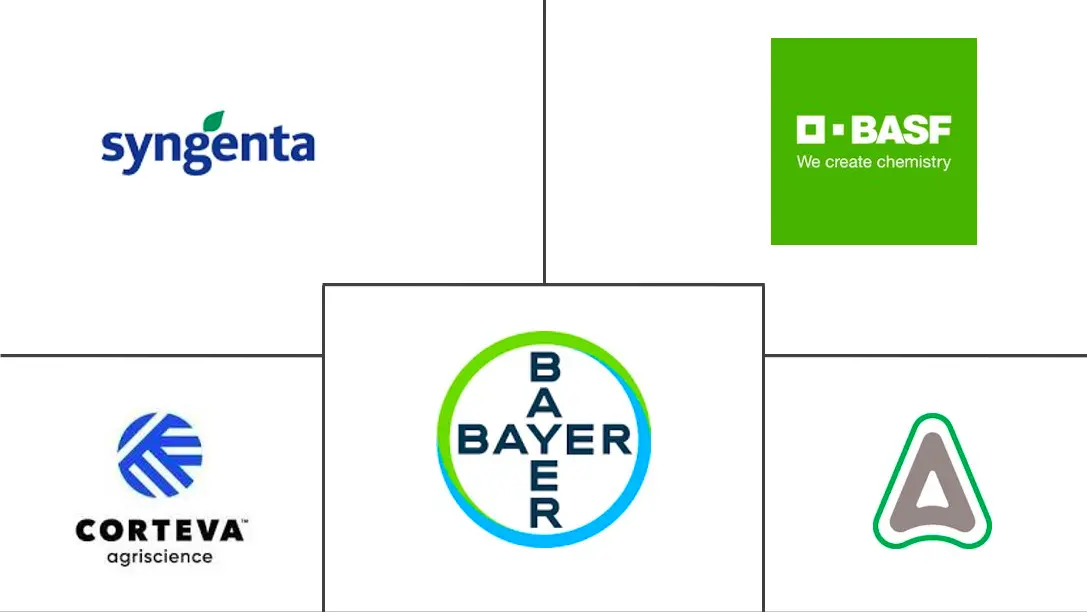Market Size of Global Chemical Seed Treatment Industry

| Study Period | 2019 - 2029 |
| Market Size (2024) | USD 7.36 Billion |
| Market Size (2029) | USD 9.31 Billion |
| CAGR (2024 - 2029) | 4.80 % |
| Fastest Growing Market | Asia Pacific |
| Largest Market | Europe |
Major Players
*Disclaimer: Major Players sorted in no particular order |
Chemical Seed Treatment Market Analysis
The Global Chemical Seed Treatment Market size is estimated at USD 7.36 billion in 2024, and is expected to reach USD 9.31 billion by 2029, growing at a CAGR of 4.80% during the forecast period (2024-2029).
The impact of the COVID-19 pandemic on the seed treatment market has been minimal, mainly due to transportation barriers. The impact of lockdowns or disruptions has been exempted by the government for all types of agricultural activities, hence there has been no such effect of corona outbreak. Indeed, the agrochemical companies have made double-digit profits as compared to last year, due to panic buying behavior from farmers. Growing awareness among farmers over the use of seed treatment has resulted in support from the government. Multiple seed banks are being managed by the governments of developing countries, at the national, as well as village levels, in order to store seeds that are properly treated by seed treatment chemicals, hence preventing the rotting of seeds. Encouraging government regulations and campaigns over the use of seed treatment is driving the market. The global market for seed treatment comprises chemical agents, including insecticides, fungicides, and other chemicals, of which chemical agents form the most dominant application segment.
Chemical Seed Treatment Industry Segmentation
Seed treatment products or the chemicals that are used to coat or treat the seeds before sowing to ensure high germination percentage. Chemical Seed Treatment Market is segmented by Chemical Type (Insecticides, Fungicides, and Other Chemicals), Crop Type (Corn, Soybean, Wheat, Rice, Canola, and Cotton), and Geography (North America, Europe, Asia-Pacific, South America, and Middle-East & Africa).
| Application | |
| Insecticide | |
| Fungicide | |
| Other Chemicals |
| Crop | |
| Corn/Maize | |
| Soybean | |
| Wheat | |
| Rice | |
| Canola | |
| Cotton |
| Geography | |||||||||
| |||||||||
| |||||||||
| |||||||||
| |||||||||
|
Global Chemical Seed Treatment Market Size Summary
The chemical seed treatment market is poised for significant growth, driven by increasing awareness among farmers and supportive government regulations. This market encompasses a range of chemical agents, including insecticides and fungicides, which are crucial for protecting seeds from pests and diseases. The demand for seed treatment is bolstered by the high costs associated with hybrids and genetically modified seeds, prompting farmers to invest in seed protection to safeguard their investments. The market's resilience during the COVID-19 pandemic highlights its essential role in agriculture, with agrochemical companies reporting substantial profits due to heightened demand. Governments in developing regions are actively managing seed banks to ensure the availability of treated seeds, further propelling market expansion.
Geographically, the Asia Pacific region leads in seed treatment consumption, with countries like China, Japan, and Vietnam adopting these products for various crops. The presence of major industry players such as Syngenta, BASF, and Bayer in this region underscores the market's potential, as these companies engage in field trials and training to promote their products. The market is characterized by consolidation, with top players holding significant market shares and focusing on strategic expansions, mergers, and partnerships to enhance their presence. Innovations like Syngenta's TYMIRIUM TM technology and BASF's Velondis biofungicide formulations reflect ongoing efforts to improve seed treatment solutions, catering to the growing demand for high-quality agricultural produce.
Global Chemical Seed Treatment Market Size - Table of Contents
-
1. MARKET DYNAMICS
-
1.1 Market Overview
-
1.2 Market Drivers
-
1.3 Market Restraints
-
1.4 Porter's Five Force Analysis
-
1.4.1 Bargaining Power of Suppliers
-
1.4.2 Bargaining Power of Buyers/Consumers
-
1.4.3 Threat of Substitute Products
-
1.4.4 Threat of New Entrants
-
1.4.5 Competitive Rivalry
-
-
-
2. MARKET SEGMENTATION
-
2.1 Application
-
2.1.1 Insecticide
-
2.1.2 Fungicide
-
2.1.3 Other Chemicals
-
-
2.2 Crop
-
2.2.1 Corn/Maize
-
2.2.2 Soybean
-
2.2.3 Wheat
-
2.2.4 Rice
-
2.2.5 Canola
-
2.2.6 Cotton
-
-
2.3 Geography
-
2.3.1 North America
-
2.3.1.1 United States
-
2.3.1.2 Canada
-
2.3.1.3 Mexico
-
2.3.1.4 Rest of North America
-
-
2.3.2 Europe
-
2.3.2.1 Spain
-
2.3.2.2 United Kingdom
-
2.3.2.3 France
-
2.3.2.4 Germany
-
2.3.2.5 Russia
-
2.3.2.6 Italy
-
2.3.2.7 Rest of Europe
-
-
2.3.3 Asia Pacific
-
2.3.3.1 China
-
2.3.3.2 Japan
-
2.3.3.3 India
-
2.3.3.4 Thailand
-
2.3.3.5 Vietnam
-
2.3.3.6 Australia
-
2.3.3.7 Rest of Asia-Pacific
-
-
2.3.4 South America
-
2.3.4.1 Brazil
-
2.3.4.2 Argentina
-
2.3.4.3 Rest of South America
-
-
2.3.5 Middle East & Africa
-
2.3.5.1 South Africa
-
2.3.5.2 Rest of Middle East & Africa
-
-
-
Global Chemical Seed Treatment Market Size FAQs
How big is the Global Chemical Seed Treatment Market?
The Global Chemical Seed Treatment Market size is expected to reach USD 7.36 billion in 2024 and grow at a CAGR of 4.80% to reach USD 9.31 billion by 2029.
What is the current Global Chemical Seed Treatment Market size?
In 2024, the Global Chemical Seed Treatment Market size is expected to reach USD 7.36 billion.

